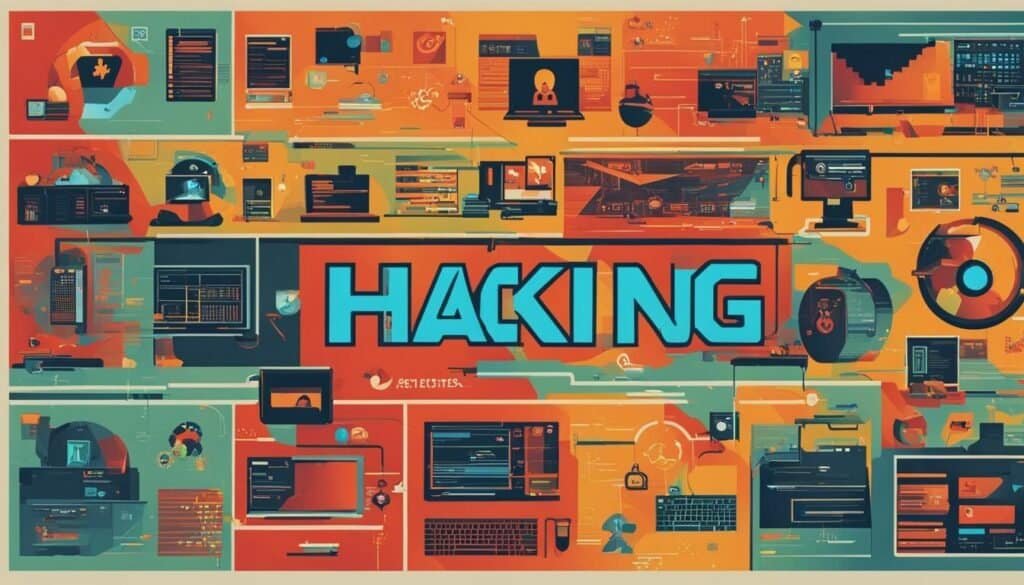Gaining a clear understanding of hacking and its various forms is crucial in today’s digital age. Hacking involves exploiting vulnerabilities in computer systems or networks to gain unauthorized access to personal or organizational data. To protect ourselves from this threat, we must be familiar with the signs of hacking and the indicators that can help us identify potential intrusions.
As we delve into the world of hacking, we will explore the techniques employed by hackers, their motivations, the history of hacking, and the potential consequences they can inflict. By recognizing these hacking indicators and understanding how hackers work, we can take proactive steps to safeguard our online security.
Key Takeaways:
- Understanding the signs and indicators of hacking is crucial for maintaining cybersecurity.
- Hackers employ various techniques such as social engineering, password hacking, and malware infection.
- Motivations for hacking range from financial gain to political espionage and hacktivism.
- The history of hacking dates back to the 1960s and has evolved with the rise of personal computers and cybersecurity threats.
- Hackers can hijack usernames and passwords, steal money, and sell personal information.
How Hackers Work
Hacking is a complex process that involves various techniques and methods. Understanding how hackers work is essential in order to protect ourselves and our systems from their malicious activities. In this section, we will explore the different aspects of hacking, from social engineering to infecting devices with malware.
Social Engineering
Social engineering is a technique that hackers use to manipulate individuals into revealing sensitive information. They prey on human vulnerabilities and exploit trust to gain unauthorized access. By impersonating someone trustworthy or disguising their intentions, hackers can trick individuals into sharing passwords, personal information, or granting them access to secure systems.
Hacking Passwords
One of the most common methods hackers use is cracking passwords. They employ techniques like brute force attacks and dictionary attacks to guess or crack weak passwords. By using sophisticated software and algorithms, hackers can systematically try a large number of combinations until they find the right one, granting them access to confidential data or systems.
Infecting Devices with Malware
Hackers often infect devices with malware to gain control or extract valuable information. They use various methods such as phishing scams, spam emails, or fake websites to deceive users into downloading malicious software. Once the malware is installed on a device, hackers can remotely monitor activities, steal sensitive data, or even take control of the device to carry out malicious actions.
Exploiting insecure wireless networks, gaining backdoor access, spying on emails, logging keystrokes, and creating zombie computers are additional techniques that hackers may utilize to infiltrate systems and compromise security. It is essential to stay informed and take necessary precautions to protect ourselves and our data from these ever-evolving threats.
Motivations for Hacking
Understanding the motivations behind hacking can help us gain insights into why people engage in such activities. While there are various motivations, money is often a significant driving force. Hackers may steal passwords and sensitive information to gain financial benefits. Another motive is corporate espionage, where hackers target organizations to steal trade secrets for competitive advantage. Political espionage is also prevalent, where hackers engage in hacking to obtain classified information or interfere with political processes, such as elections.
Revenge is another powerful motive that can lead individuals to resort to hacking. Whether it’s seeking justice for perceived wrongdoings or settling personal disputes, hackers may target individuals or organizations as a form of retaliation. Hacktivism is yet another motivation for hacking, where individuals or groups hack into systems to further political or social causes. For some hackers, the desire for notoriety or recognition drives their actions, seeking to showcase their hacking skills to gain attention.
Lastly, it’s important to acknowledge that not all hacking is malicious. Some individuals engage in hacking to improve security. Ethical hackers, also known as white hat hackers, aim to identify vulnerabilities in systems and help organizations enhance their cybersecurity defenses. By uncovering weaknesses and notifying the appropriate parties, these hackers contribute to the overall security improvements.
Table: Motivations for Hacking
| Motivation | Description |
|---|---|
| Money | Hackers target personal and organizational data to achieve financial gain. |
| Corporate Espionage | Hackers aim to steal trade secrets from organizations for competitive advantage. |
| Political Espionage | Hackers engage in political hacking to obtain classified information or interfere with political processes. |
| Revenge | Hackers seek retaliation by targeting individuals or organizations that they perceive have wronged them. |
| Hacktivism | Hackers hack to further political or social causes. |
| Notoriety | Hackers seek recognition and attention for their hacking skills. |
| Security Improvements | Ethical hackers identify vulnerabilities and help strengthen cybersecurity defenses. |
Understanding the motivations behind hacking is crucial for individuals and organizations to develop effective countermeasures. By being aware of these motivations, we can enhance our cybersecurity strategies and protect ourselves from potential threats.
The History of Hacking

Hacking has a rich and intriguing history that dates back to the 1960s. The origins of hacking can be traced to MIT’s Tech Model Railroad Club, where members who were fascinated by technology and computer systems began experimenting with modifying high-tech train sets. As their interests evolved, so did their focus, leading them to explore the world of computers and ultimately paving the way for the phenomenon we now know as hacking.
In the 1970s, phone hacking, also known as phreaking, emerged as a significant aspect of hacking culture. Enthusiasts started exploring ways to manipulate telephone systems and gain unauthorized access to their functionalities. This era of hacking laid the foundation for the subsequent advancements in hacking techniques.
The widespread availability of personal computers in the 1980s fueled the rise of hacking for personal gain. With the increasing accessibility of computer technology, hackers began exploiting vulnerabilities in software and systems to achieve their objectives. This period saw a surge in personal computer hacking, as individuals sought to gain unauthorized access to various networks and databases.
| Decade | Key Events |
|---|---|
| 1960s | MIT’s Tech Model Railroad Club experiments with computer systems |
| 1970s | Rise of phone hacking or phreaking |
| 1980s | Increase in personal computer hacking |
| 1990s | High-profile cybercrimes and arrests of hackers |
| 2000s and 2010s | Rise of government and corporate cybersecurity hacking |
The 1990s marked a turning point in hacking history with several high-profile cybercrimes capturing public attention. Notable arrests and prosecutions during this time shed light on the potential dangers posed by hackers and intensified efforts to combat cyber threats.
In the 2000s and 2010s, hacking took on a new dimension, with governments and corporations becoming prime targets for cyber attacks. Heightened cybersecurity measures were implemented to protect sensitive data and prevent unauthorized access to critical systems. This period witnessed an increased focus on government and corporate cybersecurity hacking, amplifying the need for robust security measures and continuous innovation in the field of cybersecurity.
What Hackers Can Do

When hackers successfully breach a computer system or network, they can carry out a range of devastating actions that can have serious consequences for individuals and organizations alike. Understanding what hackers are capable of is crucial in recognizing the importance of robust cybersecurity measures. Let’s explore some of the potential outcomes of a successful hacking attempt:
Table: Consequences of Hacking
| Hacking Consequences | Description |
|---|---|
| Hijacking Usernames and Passwords | Hackers can gain access to user accounts, compromising sensitive data and enabling further unauthorized actions. |
| Stealing Money | Hackers may exploit vulnerabilities to siphon funds from bank accounts or make fraudulent transactions. |
| Ruining Credit | By acquiring personal information, hackers can damage credit ratings and cause financial distress for their victims. |
| Requesting New Account PINs | Hackers can manipulate account settings to request new PINs, enabling access to secure information. |
| Making Unauthorized Purchases | Using stolen credentials, hackers can make unauthorized purchases, leading to financial loss for individuals and businesses. |
| Abusing Social Security Numbers | Hackers can exploit Social Security numbers for identity theft, leading to a multitude of fraudulent activities. |
| Selling Personal Information | Personal information obtained by hackers can be sold on the dark web, further compromising individuals’ privacy and security. |
These consequences highlight the extent of the damage that can be caused by hackers and emphasize the importance of implementing robust cybersecurity measures. It is crucial for individuals and organizations to stay vigilant, proactively protect their systems and networks, and promptly respond to any security breaches.
By understanding what hackers can do, we empower ourselves to take the necessary steps to safeguard our sensitive information. With the ever-increasing threat landscape, it is vital to stay informed and regularly update our security protocols.
Recognizing Hacking Indicators
In today’s digital landscape, it is crucial to be aware of hacking indicators to protect our personal and organizational data. By familiarizing ourselves with key signs, we can detect hacking attempts, identify unauthorized access, spot hacking activities, and recognize hacking techniques. Being proactive in recognizing these indicators allows us to take prompt action to safeguard our digital assets.
Common Hacking Indicators
There are several common indicators that may suggest hacking attempts. Unusual account activity, such as unrecognized logins or suspicious transactions, should immediately raise concerns. If you receive notifications of failed login attempts or notice unfamiliar programs or software on your devices, it may indicate unauthorized access.
Changes in system performance, such as slow response times or sudden crashes, can also be red flags. Unexpected pop-ups or advertisements and increased network traffic without any apparent reason may indicate the presence of malware or hacking activities.
Recognizing Hacking Techniques
Hackers employ various techniques to gain access to sensitive information. Familiarizing ourselves with these techniques can help us recognize potential hacking attempts. Some common techniques include phishing, where hackers use deceptive emails or websites to trick individuals into sharing personal information. Another technique is brute-force attacks, where hackers systematically try different combinations of passwords to gain unauthorized access.
Additionally, hackers may use social engineering to manipulate individuals into disclosing confidential information or exploiting vulnerabilities in wireless networks to gain entry. By staying informed about these techniques, we can be better prepared to identify and prevent hacking attempts.
Summary
Recognizing hacking indicators is essential to protect ourselves from cyber threats. By being vigilant and aware of signs such as unusual account activity, changes in system performance, and the presence of unfamiliar programs or software, we can detect potential hacking attempts. Understanding common hacking techniques like phishing and social engineering can further enhance our ability to identify unauthorized access and hacking activities. By staying informed and proactive, we can safeguard our digital assets and maintain a secure online environment.
Protecting Against Hacking
Preventing hacking is essential to safeguarding your personal and organizational data. By implementing a few key measures, you can significantly enhance your cybersecurity defenses. Here are some effective strategies:
1. Secure Email Communication
Using secure email communication is crucial in protecting sensitive information from falling into the wrong hands. Encryption and authentication technologies ensure that your emails are encrypted during transmission and can only be accessed by authorized recipients. By encrypting your emails, you can reduce the risk of hackers intercepting and accessing your confidential data.
2. Secure Data Backups
Backing up your data regularly is a fundamental practice that helps protect against data loss caused by hacking incidents. Consider using cloud-based storage systems for your backups, as they offer enhanced security measures and redundancy. By storing your data in the cloud, you can ensure that even if your primary systems are compromised, you can quickly recover your data and resume operations without significant disruptions.
3. Empowering Employees
Your employees play a crucial role in maintaining cybersecurity. Providing comprehensive cybersecurity training and awareness programs can empower them to identify and respond appropriately to potential hacking attempts. Educate employees about common hacking techniques, such as phishing scams and social engineering, and train them on how to spot and report suspicious activities or emails. By fostering a culture of cybersecurity awareness, you can minimize the chances of successful hacking attempts.
4. Cyber Resilience
Adopting a cyber resilience strategy is vital in mitigating the impact of hacking incidents. Cyber resilience involves a combination of preventive and responsive measures to protect against, detect, and recover from cyber attacks. This strategy includes regular vulnerability assessments, proactive monitoring of network traffic, incident response planning, and continuous improvement of security protocols. By taking a holistic approach to cybersecurity, you can ensure that your organization is well-prepared to withstand hacking attempts and quickly recover from any breaches.
Protecting against hacking requires a proactive and multi-faceted approach. By implementing secure email communication, maintaining secure data backups, empowering employees through training, and embracing a cyber resilience strategy, you can significantly enhance your defenses against hacking incidents and safeguard your valuable data.
Conclusion
In conclusion, cybersecurity is of utmost importance in ensuring online safety and protecting against hacking. The threat posed by hackers is significant, and understanding their techniques and motivations is essential in order to defend ourselves and our organizations.
By recognizing hacking indicators such as unusual account activity and unauthorized access attempts, we can be better prepared to detect and respond to hacking attempts. Implementing preventive measures, such as secure email communication and secure data backups, can significantly reduce the risk of data loss or unauthorized access.
Additionally, empowering employees through cybersecurity training and fostering a culture of cyber resilience are crucial in preventing human errors that may lead to hacking incidents. By combining prevention and mitigation measures, we can enhance our overall security and protect ourselves from cyber threats.
Remember, maintaining a strong cybersecurity posture is an ongoing effort. By staying vigilant, following best practices, and staying up-to-date with the latest security measures, we can ensure our online safety and protect ourselves against the ever-evolving landscape of hacking.
How Does Hacking in Computer Work?
Hacking in computer explained: Hacking involves exploiting weaknesses in computer systems to gain unauthorized access or control. It typically starts with reconnaissance to gather information about the target. Next, hackers find vulnerabilities to exploit, such as weak passwords or software bugs. Once inside, they can steal data, install malware, or disrupt operations. Protecting against hacking requires robust security measures and staying vigilant against emerging vulnerabilities.
FAQ
What does hacking look like?
Hacking is the act of identifying and exploiting weaknesses in a computer system or network to gain unauthorized access to personal or organizational data. It can involve techniques such as social engineering, hacking passwords, infecting devices with malware, exploiting insecure wireless networks, and more.
How do hackers work?
Hackers employ various techniques such as social engineering, hacking passwords, infecting devices with malware, exploiting insecure wireless networks, gaining backdoor access, spying on emails, logging keystrokes, and creating zombie computers to gain unauthorized access.
What motivates hackers?
Hackers have various motivations, including financial gain, corporate espionage, political espionage, revenge, hacktivism, seeking notoriety, recognition, and even improving security through ethical hacking.
What is the history of hacking?
Hacking originated in the 1960s at MIT’s Tech Model Railroad Club and evolved from modifying high-tech train sets to experimenting with computers. The 1970s saw the emergence of phone hacking, followed by increased hacking for personal gain in the 1980s. The 1990s witnessed high-profile cybercrimes, and the 2000s and 2010s saw cybersecurity hacking targeting government agencies, corporations, and individuals.
What can hackers do?
Once hackers gain unauthorized access, they can hijack usernames and passwords, steal money, ruin credit ratings, make unauthorized purchases, abuse Social Security numbers, sell personal information, delete or damage files, and obtain sensitive information.
How can I recognize hacking indicators?
Look out for signs such as unusual account activity, unauthorized access attempts, unfamiliar programs, changes in system performance, unexpected pop-ups, increased network traffic, system crashes, unexpected password changes, and the presence of unknown files or programs.
How can I protect against hacking?
Protect yourself by implementing secure email communication, secure data backups, employee cybersecurity training, and adopting a cyber resilience strategy that combines prevention and mitigation measures.
What is the conclusion?
Understanding the various techniques hackers use, their motivations, and recognizing hacking indicators can help individuals and organizations protect themselves against hacking and enhance their cybersecurity.




0 Comments